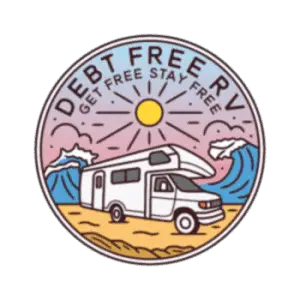Is there really just one “best” way to make coffee in an RV?
Since living in our RV, we’ve found that the best method is the one that best suits your lifestyle on the road, considering factors like: your RV’s electric requirements/accessibility, and whether you prefer automatic brewing or more hands-on cup of joe.
Being full time RVers for a number of years, we’ve run the gamut of coffee-making methods; Each approach having their own pros and cons. So, here’s our list of the best way to make coffee in an RV, to help you find what works best for you!
“No Electricity Required” Methods
#1. French Press

Using a French Press is a quintessential “van life” coffee appliance for a few reasons. The first being, a French Press doesn’t require electricity to brew your coffee. If you’re boondocking and don’t always have access to A/C power (ie plugging in to outlets to run appliances), a French Press is the perfect solution.
When we’re not being lazy RVers and make coffee with Instant Coffee, we still use our trusty French Press!
Brewing coffee in a French Press is simple: Boil water in a kettle, spoon your coffee grounds into your Press, pour in the hot water, place the top on the Press and in a few minutes, slowly push the top down until it reaches the bottom of the cylinder, and voila!
You’ve got a few cups of delicious home-brewed coffee!
You can also brew espresso in a French Press, just be aware that coffee grounds and espresso beans need to be more ground more coarsely. In a regular espresso maker, for instance, espresso is typically ground into a fine powder…
But in a French Press, the grounds should be slightly more grainy in order to not fall through the strainer mesh.
#2. AeroPress

Much like the French Press, the AeroPress is one of the best ways to make coffee in an RV, due to its simplicity, ease of use, and compact size.
The AeroPress is a plastic press, and yields 1-3 cups of coffee. The approach to making coffee in this is very similar to a traditional French Press, however, unlike the French Press, the AeroPress is not 100% waste-free.
An AeroPress comes in three pieces: the brew chamber (cylinder), the plunger, and the basket. The basket is where you’ll need to place the small, paper coffee filter; This is the portion that produces waste- although there are now reusable alternatives available like these steel filters.

One great feature of the AeroPress is its compact size. It’s easy pack away in purse, bag or backpack, and can easily be brought camping, on hikes or other adventures! Beyond bringing it wherever you want to go, it makes a mean cup o’ joe!
#3. Percolator

Percolators are great little coffee makers to brew your coffee or espresso. Percolators were invented in the late 1800’s, and are so efficient and functional that they’re still used today!
Of these simple appliances, the most basic is the traditional stove top percolator. Having a coffee maker that doesn’t rely on access to electricity is great, not just for RVers, but for anyone who’s experienced a power outage!
Coming in just a few pieces, a standard percolator consists of the brewing chamber, steel filter/basket, its lid, and a rod.
Brewing coffee or espresso is easy: Pour water in the main chamber, spoon the desired amount of coffee grounds in the basket, place the rod in the chamber- followed by the basket- place the lid on the basket, put the percolator on the stove, and start brewing!
One thing about percolators is that they often brew at higher temperatures than other methods, so if you’re not careful, it’s easy to over-extract from the grounds. This means that your RV might smell like the best pot of coffee this side of the tracks, but the actual coffee may be weaker…
For this reason, the percolator wasn’t our favorite option, but the smell of brewing coffee in our RV was great.
“Electricity-Required” Coffee Methods
#4. Keurig

One of the most popular brands of coffee makers, Keurigs are easy to use and have so many “extras” available, they can be a fun addition to your RV’s kitchen.
These coffee machines come in various sizes from the Keurig K-Mini that brews single-servings, or the more standard-sized Keurigs which can brew 6, 8, or 10 oz cups of coffee at a time.
They do require the use of an electric outlet, so these can only be used if you have access to shore power or can run your generator. So, if you’re regularly boondocking without frequent access to power, an electric machine might not be the best fit for your lifestyle.
Besides the electricity requirement, Keurigs take up a bit of space in the kitchen. Space in RVs is always at a premium, so the Mini version might save you some much-needed room compared to its larger counterpart.
Keurig has been criticized for the amount of plastic waste created by their single-use coffee pods, so if you’re trying to mitigate the amount of trash you product while brewing coffee, there are reusable pod alternatives available.

Some perks of having a Keurig is how hands-off they are. Pour water into the machine, place your mug to catch the coffee, press the “brew” button and come back when it’s ready!
There’s also a huge variety of delicious drinks to choose, from donut-flavored coffee, to sweet apple cider, hot chocolate, matcha green tea, and lattes (Amazon)you can even purchase a sampler of all of these drinks for your Keurig and have them on standby!
As you can see, there’s plenty of different methods to make the best coffee in an RV- it all depends on your personal lifestyle. If self-reliance and off-grid living is important to you, try one of the many non-electric methods. If you’re a lover of a wide range of flavored drinks and are hooked up to electricity, a Keurig might better suit you!
Whatever way you choose to live and travel, you can find the right coffee maker to fit your lifestyle!

